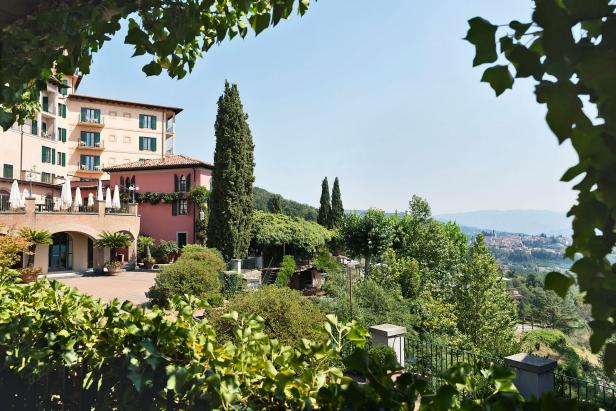
Don’t let peak tourist season scare you away from perennial favorite Tuscany. Instead, leave Pisa, Siena, and much of Florence to the hordes, and explore these lesser known, but no less worthy, places instead.
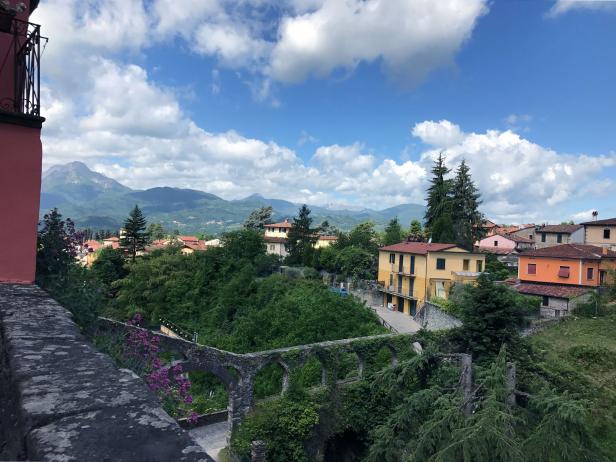
Photo by: Meredith Rosenberg
Meredith Rosenberg
Barga
This compact medieval town, about an hour and a half northwest of Florence, is so off the grid that even native Italians haven’t heard of it. In fact, the entire Garfagnana region is devoid of the tourist hordes, making it the perfect base for day trips.
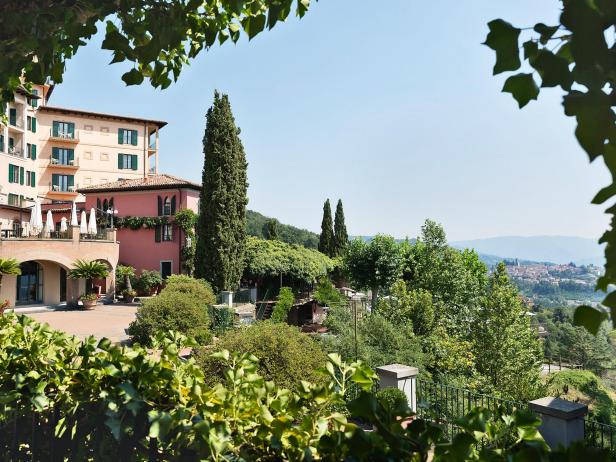
Renaissance Tuscany Exterior
Photo by: Renaissance Tuscany
Renaissance Tuscany
Start by making the four-star Renaissance Tuscany Il Ciocco Resort & Spa, known by locals as Il Ciocco, your temporary home. It’s a short (yet very twisty) drive away from Barga in the lush Serchio Valley, and its location on 1,700 acres ensures that all you’ll hear is birdsong and hooting owls. Though technically a Marriott, little is cookie cutter about this former hunting lodge turned 180-room resort, complete with its own piazza. Since it’s so remote, on-site amenities encompass an outdoor pool with unencumbered views of the valley, a full-service spa and a fitness center with an indoor pool. There are also hilly walking trails for the ambitious, including one that leads to Barga if you can last an hour.
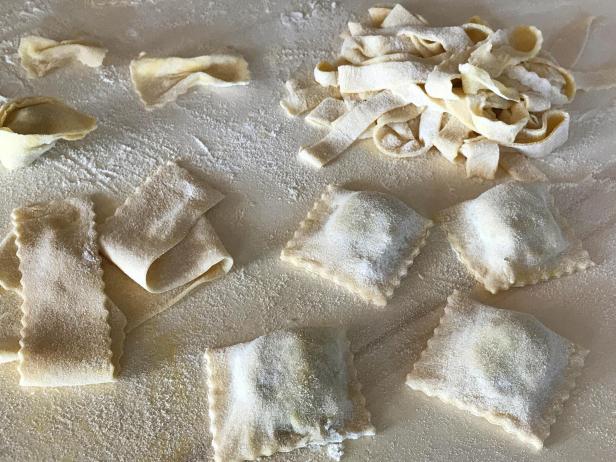
Pasta Tuscany
Photo by: Meredith Rosenberg
Meredith Rosenberg
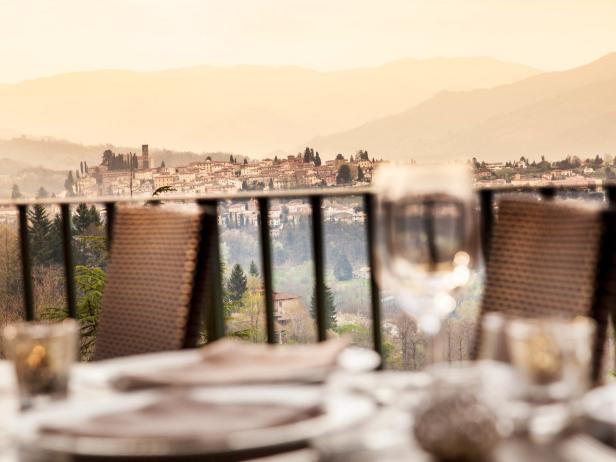
Renaissance Tuscany Terrace
Photo by: Renaissance Tuscany
Renaissance Tuscany
Dine at La Veranda, which specializes in regional cooking from spelt tagliatelle to vegetable soup, and, like much of the property, offers exceptional views. Or up your cooking game by taking a cooking class that starts with a trip into Barga with the hotel’s chef. Customize your meal, or let the chef choose for you. You’ll get to prep your ingredients at the private Le Salette restaurant, whether learning how to make gnocchi, maltagliati (a type of pasta), or a barghigiana sauce with meat and mushrooms. Make the tortino di ricotta e cioccolato (chocolate and ricotta cake) for dessert, then feast on the private terrace. Organic garden fans should take note that a new addition will provide meals with fresh herbs, tomatoes and more, and eventually encompass everything from fava beans to eggplant.
For a change of pace, head into Barga to experience Scacciaguai, a popular spot among locals for both classic and modern Italian cuisine. You can’t go wrong with the chestnut flour tagliatelle, or really anything with truffles. An unexpected highlight is the ability to watch the kitchen on a TV screen. Don’t leave before finding the small wall sculpture around the corner from the restaurant. Local lore claims that sticking your fingers in the holes will make your troubles disappear — couldn’t hurt, right?
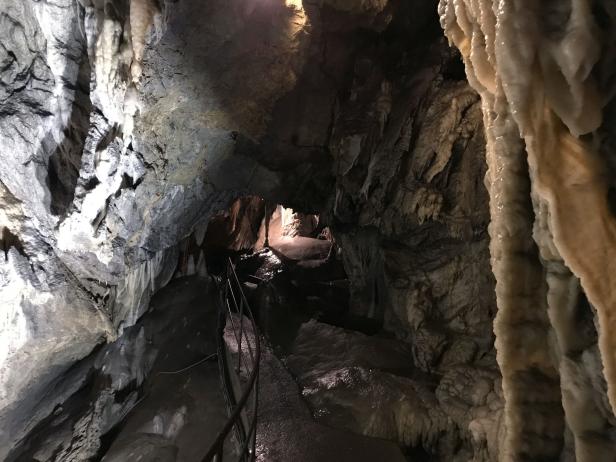
Wind Cave Tuscany
Photo by: Meredith Rosenberg
Meredith Rosenberg
While you’re in the area, drive a half hour southwest to the Grotta del Vento, or wind cave, named for the air current that flows through it. Here you’ll find underground lakes and otherworldly limestone and alabaster formations. Choose from one-, two- or three-hour tours — just be forewarned that the latter involves almost 1,200 steps. Hard-core cavers can even opt for tours that go off trail. And don’t forget to dress in layers, since the cave averages about 50 degrees year-round.
Castelnuovo di Garfagnana
A fifteen-minute drive north brings you to the ancient town of Castelnuovo di Garfagnana, whose history can be traced back to the 8th century. Wander the cobblestone streets and note the remains of the 16th-century fortress. When you get snacky, pop into Il Vecchio Mulino da Andrea, a quaint tavern that’s part of Italy’s slow food movement. (Think of it as a precursor to the farm-to-table trend, as it follows the same principles.) You can identify slow food restaurants by the snail symbol. Sample local meats and cheeses at a communal table; if you happen to be carsick from the endlessly curving roads, Andrea, the owner, won’t hesitate to brew you some bitter, but effective, herbal tea.
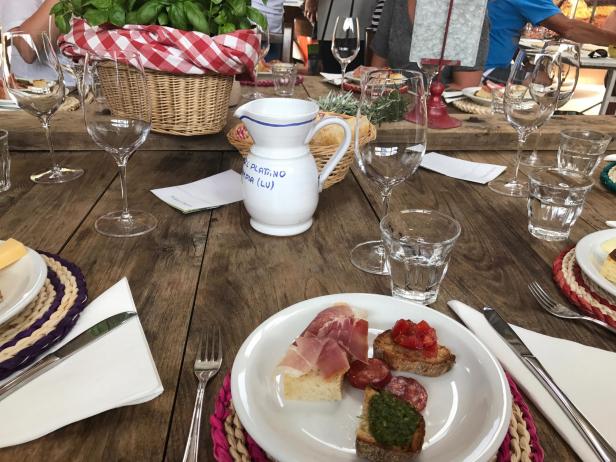
Podere Concori Tuscany
Photo by: Meredith Rosenberg
Meredith Rosenberg
In keeping with the slow food movement theme, it makes sense to visit Podere Concori (pictured), a biodynamic winery just ten minutes away from Castelnuovo di Garfagnana. As a biodynamic winery, it eschews any chemicals, artificial means or unnatural interference, and instead factors in lunar cycles and astrology in order to produce sulfate-free wine. It should come as no surprise that come fall harvest time, women crush the grapes with their bare feet. Visitors can also partake in this tradition, but sorry guys — this is a women-only ritual. Either way, go to taste the small, but quality production, including the 2015 pinot noir, while discussing all of your burning wine questions with Gabriele, the owner. A light lunch is provided, including a simple pasta dish, local meats and cheeses, and the freshest tomatoes you will ever taste. Before leaving, you can even arrange to have your favorite wines shipped home.
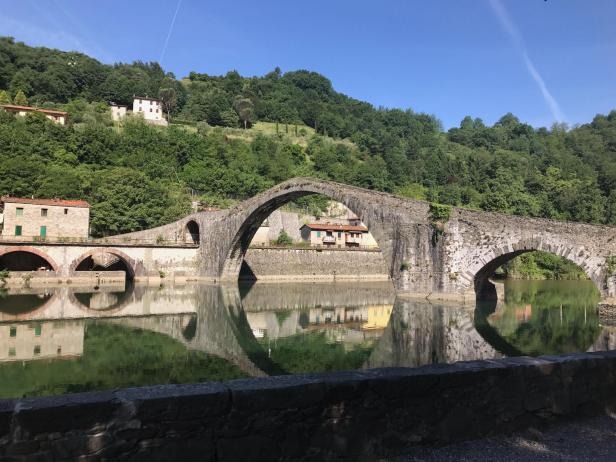
Devils Bridge Tuscany
Photo by: Meredith Rosenberg
Meredith Rosenberg
En route to Lucca, make time to stop at the incredibly scenic Ponte della Maddalena (pictured), commonly called the Devil’s Bridge. Like much of the region, it was built in the Middle Ages. It’s believed that the bridge’s purpose was to allow pilgrims to travel to Rome, but the legend is more entertaining. In that tale, the devil promised to have the bridge finished in one night in exchange for the soul of the first one to cross. The builder outwitted him by sending a pig over first, causing the devil to hurl himself over the bridge, never to be seen again. The bridge is now a popular spot for major Halloween festivities.
Lucca
Although larger than Barga or Castelnuovo di Garfagnana, this medieval town about an hour south is the perfect place to pass the afternoon, without the masses you’ll find in neighboring Pisa. Take a bike tour to get your bearings, then wander its picturesque piazzas and narrow streets filled with shops and restaurants. Stop for a leisurely lunch at Gli Orti di via Elisa for traditional fare, from spelt anything (popular in the region), to salt cod with chickpeas. In local news, fans of the Renaissance Tuscany hotel should note that the owners are restoring the centrally located Hotel Universo; it will reopen as the Grand Universe Lucca, part of the high-end Marriott Autograph Collection, in 2018.
Fiesole
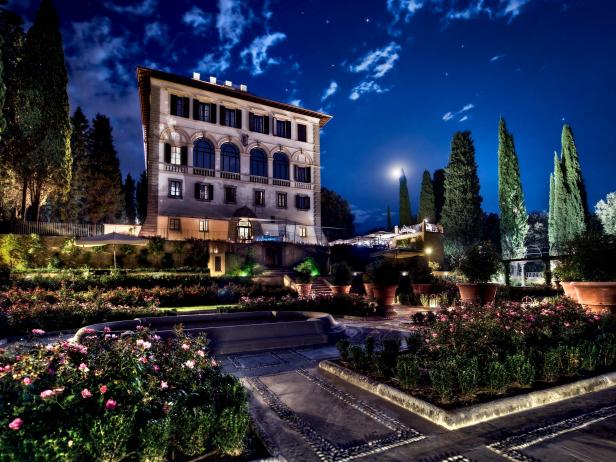
Il Salviatino
Photo by: Il Salviatino
Il Salviatino
When you’re done exploring the Garfagnana region, head to Il Salviatino in Fiesole. This small hill town just outside of Florence makes for a perfect retreat while exploring the city. Even better, the five-star, 15th-century palazzo feels like crashing in a wealthy friend’s home, except no worries about overstaying your welcome here. The property overlooks 12 private acres, with the whole of Florence just beyond. That is, if you can take your gaze off the manicured gardens — which you don’t have to if you book a room with a view.
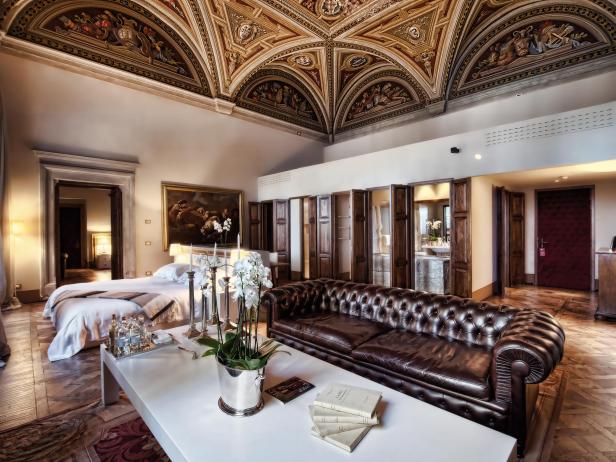
Il Salviatino Suite
Photo by: Il Salviatino
Il Salviatino
Although if you’re splurging for a special occasion, the Affresco suite, complete with an ancient stone bathtub and a 19th-century ceiling fresco (pictured), is also mind-blowing. Spend your downtime at the intimate spa, outdoor pool or light-filled library. Meals are meant to be enjoyed alfresco here, from the breakfast buffet tables laden with fruit, meats, pastries and more to watching the sunset over the city.
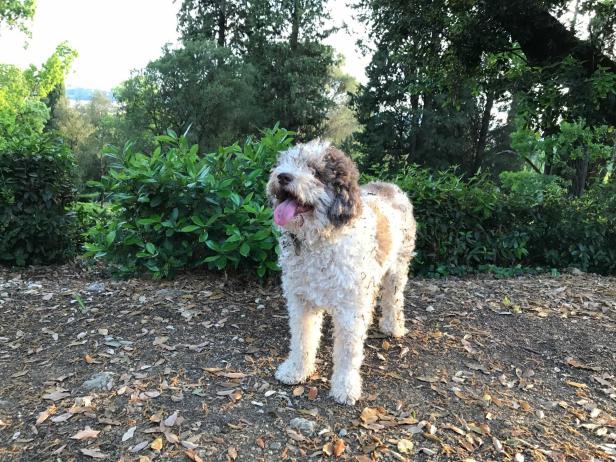
Truffle Hunting Dog Tuscany
Photo by: Meredith Rosenberg
Meredith Rosenberg
Speaking of sunset, pass the evenings by learning how to make a negroni, or take advantage of the ability to go truffle hunting on the property with Eda (pictured). (Although pigs were traditionally used, dogs have since replaced them.) Enjoy shaved truffles with your meal if you’re lucky enough to find the elusive shrooms, although Eda usually brings her A game. It’s also worth noting that the villa will be adding a 5,000-square-foot organic vegetable garden on the grounds in the near future.
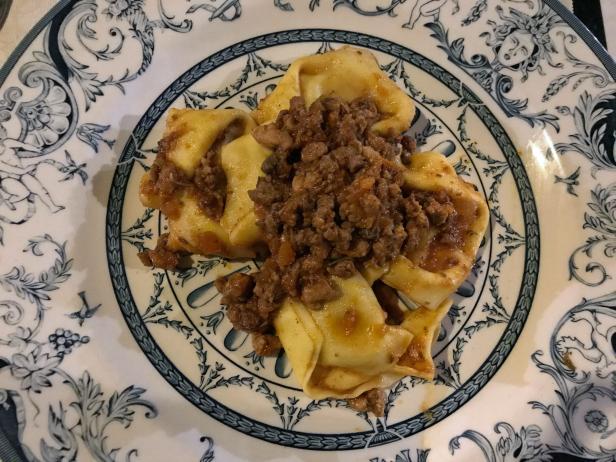
La Cave Di Maiano
Photo by: Meredith Rosenberg
Meredith Rosenberg
While the meals at Il Salviatino are first-rate, do get over to La Cave Di Maiano (pictured) in Fiesole, a local favorite specializing in regional dishes. Sit outside on the terrace to gaze at the view, which feels like a Tuscan watercolor. Diners come for the bistecca alla fiorentina, but you can’t go wrong with any of the homemade pasta dishes or decadent chocolate desserts.
Greve in Chianti
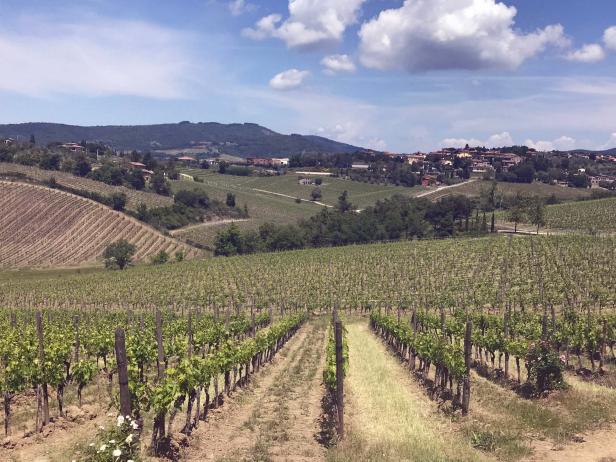
Chianti Wine Tuscany
Photo by: Meredith Rosenberg
Meredith Rosenberg
If you can tear yourself away from Il Salviatino, head about an hour south to the Chianti region for wine tasting. Stop in Greve in Chianti, a small, bustling town that’s considered the gateway to the region. Independent shops surround the square; stop in Bottega dell’Artigianato for hand-woven baskets and olive wood kitchenware. If possible, don’t miss the Saturday farmer’s market.
Among the area wineries worth visiting, make reservations in advance for Colle Bereto, a gorgeous vineyard surrounded by olive groves just outside the village of Radda. Tour the property, then enjoy a light lunch of pasta, fresh prosciutto and cheese while tasting classic Chiantis. The organic winery also produces a small selection of red (merlot, pinot noir) and white (chardonnay, pinot blanc) blends. You can’t buy it, but ask if you can sample the Vin Santo, a regional dessert wine with heavenly butterscotch notes, which is made in small batches. However, you can buy olive oil and honey that taste far superior to mass-produced brands. (In case you couldn’t make a reservation in time, there’s also a Florence outpost for food and drink.)
Florence
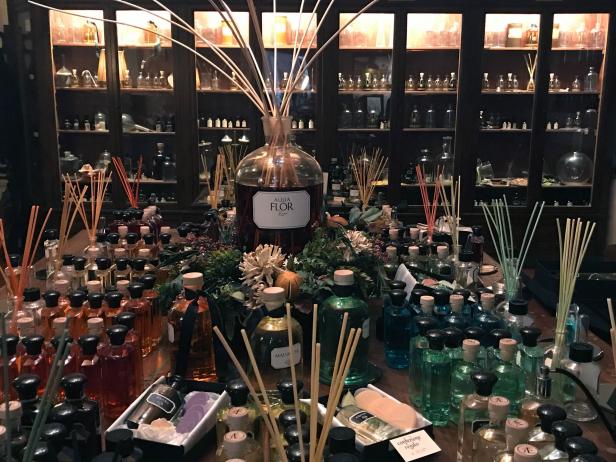
Aguaflor Tuscany
Photo by: Meredith Rosenberg
Meredith Rosenberg
Ok, so the secret is out about Firenze, Tuscany’s capital, but there are lesser-known experiences to be had beyond the Duomo and Uffizi. You’ve likely heard of Santa Maria Novella, arguably the world’s oldest purveyor of perfume and skincare products, so head to AquaFlor near Santa Croce for a less crowded experience. Tucked away on a side street, the dark-wood interior evokes an old-world apothecary in a private residence, where dozens of glass bottles line antique shelves. You could easily spend hours sniffing about 1,500 unisex scents; better yet, sign up for a workshop to make your own customized perfume. Classes are held downstairs in a perfume laboratory and last an hour and a half. Learn the difference between top, heart and base notes, then play mad scientist as you sniff, measure and mix your own 100 ml creation. Alternatively, master perfumer Sileno Cheloni can customize a scent for you, as he was recently doing for a VIP client in Oman.
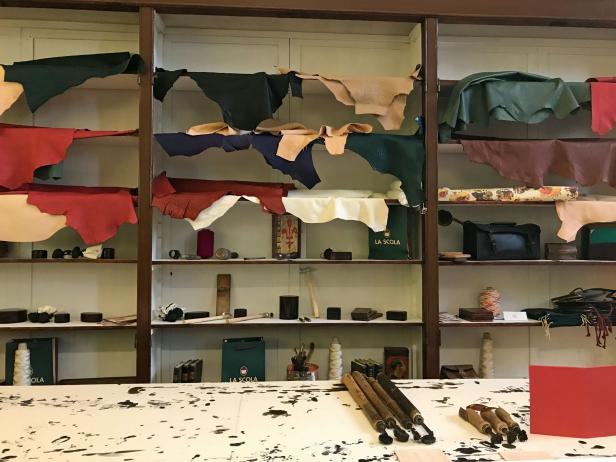
Leather Making Tuscany
Photo by: Meredith Rosenberg
Meredith Rosenberg
Leather making is another time-honored tradition in Florence. You can learn about the art at La Galleria Michelangelo, which Il Salviatino can arrange. The three-hour workshop allows you to make your own notebook and marbled paper under the guidance of a master crafter — guaranteed to be a more memorable souvenir than anything you could buy. Of course, the store also sells handcrafted leather bags should you care to go that route too.
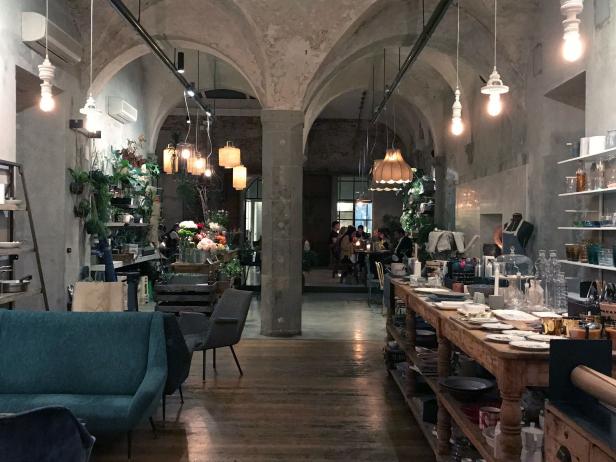
La Menagere Tuscany
Photo by: Meredith Rosenberg
Meredith Rosenberg
After a full day of activities, unwind at La Menagère, a hybrid restaurant/café/bar that feels like a cross between Anthropologie and ABC Kitchen in NYC, complete with a flower boutique and curated shop. Linger over octopus, cacio e pepe gnocchi and craft cocktails while plotting your return trip. Cap off the evening by popping downstairs for live jazz.
This trip was sponsored by the Renaissance Tuscany and Il Salviatino hotels.
